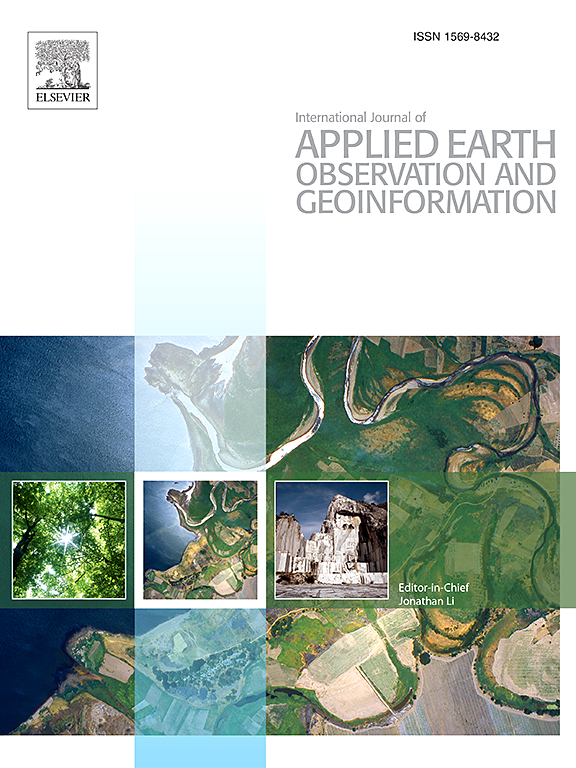S2-IFNet: A spatial-semantic information fusion network integrated with boundary feature enhancement for forest land extraction from Sentinel-2 data
IF 7.6
Q1 REMOTE SENSING
International journal of applied earth observation and geoinformation : ITC journal
Pub Date : 2025-04-03
DOI:10.1016/j.jag.2025.104505
引用次数: 0
Abstract
Accurately extracting forest land and understanding its spatial distribution are crucial for forest monitoring and management. However, variations in tree species, human activities, and natural disturbances create diverse and distinct forest land characteristics in remote sensing images, posing challenges for precise forest land extraction. To address these challenges, we propose a spatial-semantic information fusion network (S2-IFNet) integrated with boundary feature enhancement for forest land extraction from Sentinel-2 data. S2-IFNet employs a dual-branch network to separately extract the spatial and semantic features of forest land. In the semantic branch, two modules are introduced: a boundary enhancement module using the Sobel operator to capture forest land boundary details, and an attention module to strengthen the feature representation capability. Finally, a spatial-semantic fusion module effectively combines the spatial, semantic, and boundary detail information to improve the forest land extraction accuracy. S2-IFNet was evaluated across five regions in different global climate zones, with a comparative analysis conducted against four forest land-cover products in Yunnan, China. The results show that S2-IFNet can achieve an overall accuracy exceeding 90%, demonstrating its strong forest land extraction capability. Compared to the different forest land extraction models, S2-IFNet shows a superior performance, with ablation experiments confirming the effectiveness of each module. In particular, the boundary feature enhanced spatial-semantic fusion strategy enables S2-IFNet to focus more precisely on the boundaries and range of forest land, thereby enhancing the extraction accuracy. Meanwhile, S2-IFNet can adapt to complex scenarios, including varying forest density and similar object confusion. Furthermore, S2-IFNet can achieve results that are superior to the four other products.
S2-IFNet:基于边界特征增强的空间语义信息融合网络,用于Sentinel-2数据林地提取
准确提取林地并了解其空间分布对森林监测和管理至关重要。然而,由于树种、人类活动和自然干扰的变化,在遥感图像中形成了多样而独特的林地特征,这给林地的精确提取带来了挑战。为了解决这些挑战,我们提出了一个集成边界特征增强的空间语义信息融合网络(S2-IFNet),用于从Sentinel-2数据中提取林地。S2-IFNet采用双分支网络分别提取林地的空间特征和语义特征。在语义分支中,引入了两个模块:利用Sobel算子捕获林地边界细节的边界增强模块和增强特征表示能力的关注模块。最后,空间语义融合模块有效地结合了空间、语义和边界细节信息,提高了林地提取的精度。S2-IFNet在全球不同气气带的5个地区进行了评估,并与中国云南的4种森林土地覆盖产品进行了比较分析。结果表明,S2-IFNet总体精度超过90%,显示出较强的林地提取能力。对比不同的林地提取模型,S2-IFNet表现出较好的性能,并通过烧蚀实验验证了各模块的有效性。其中,边界特征增强的空间语义融合策略使S2-IFNet能够更精确地关注林地的边界和范围,从而提高提取精度。同时,S2-IFNet可以适应复杂的场景,包括不同的森林密度和类似的物体混淆。此外,S2-IFNet可以达到优于其他四种产品的效果。
本文章由计算机程序翻译,如有差异,请以英文原文为准。
求助全文
约1分钟内获得全文
求助全文
来源期刊

International journal of applied earth observation and geoinformation : ITC journal
Global and Planetary Change, Management, Monitoring, Policy and Law, Earth-Surface Processes, Computers in Earth Sciences
CiteScore
12.00
自引率
0.00%
发文量
0
审稿时长
77 days
期刊介绍:
The International Journal of Applied Earth Observation and Geoinformation publishes original papers that utilize earth observation data for natural resource and environmental inventory and management. These data primarily originate from remote sensing platforms, including satellites and aircraft, supplemented by surface and subsurface measurements. Addressing natural resources such as forests, agricultural land, soils, and water, as well as environmental concerns like biodiversity, land degradation, and hazards, the journal explores conceptual and data-driven approaches. It covers geoinformation themes like capturing, databasing, visualization, interpretation, data quality, and spatial uncertainty.
 求助内容:
求助内容: 应助结果提醒方式:
应助结果提醒方式:


